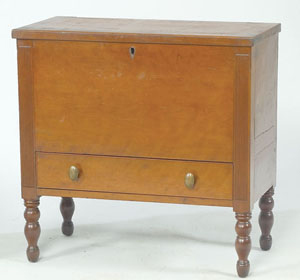
Long obsolete, sugar chests have become collector favorites. Most sugar chests come from Kentucky, Tennessee and North Carolina, but they also were produced in New Jersey, Ohio and Pennsylvania. Southern sugar chests are a better choice because the market for collecting Americana of the South has escalated considerably.
Sugar chests are case pieces. Much like a chest of drawers, presses or blanket chests, a sugar chest is essentially a box with the specific function of housing light and dark sugar. In the late 18th and early 19th centuries, sugar was a valuable commodity. Those who could afford sugar kept it under lock and key. Early sugar chests were made to suit that purpose and to make a statement that a family was sufficiently affluent to purchase sugar.
Sugar being a precious commodity, sugar chests were not ordinary storage pieces, that families socked away behind the home in a summer kitchen. Usually made of walnut or cherry, sugar storage pieces were chests of valuable hardwood. Often decorated with fine line inlay, the chests were finished on all sides and generally were made on at least 4-inch legs. Sugar chests were kept in prominent spaces where families would entertain, such as dining rooms or in parlors.
Most sugar chests were made with flat-hinged tops that locked. The interior storage area was divided into two sections – one for light sugar and one for dark. Drawers beneath the sugar storage area housed spices, teas or coffee. These drawers may or may not have locks.
As sugar became more affordable, cabinetmakers continued to make sugar chests well into the 1840s, although the form changed. Sugar storage pieces became vernacular pieces and affluent households came to regard them as outmoded. With time, significant differences between early and later forms of sugar chests emerged. The two main differences are chest size and leg design.
Early chests are much smaller. Larger chests from the later period tended to be characterized by thickly turned legs. Some early chests stood on tapered legs and were slant-front desks, called sugar desks. The form served several purposes: sugar was in a lockable area inside the lid, and the fall front could be used as a writing surface. Sugar tables developed, as did sugar sideboards. The inventiveness of cabinetmakers with these forms is a key determinant of their charm and appeal to today’s collector, and of their value in the marketplace.
Sugar chests and desks can be found in private antique shops and at auction. Expect to pay $1,000 to $3,000 for larger chests, while small early chests may command as much as $30,000, depending on form, decoration, condition and provenance.
What to Look for in collecting sugar chests:
- Case pieces – either chests or small slant desks.
- Interiors that are, or have evidence of being, divided into two sections.
- Cherry or walnut as the primary wood.
- Turned or tapering legs.
- Inlay – usually those with inlay are the most desirable forms.
- Smaller case pieces, or the earlier forms, are sought more than later big, boxy pieces.
- Avoid finished or varnished interiors or pieces that have been aggressively refinished
Wes Cowan is founder and owner of Cowan’s Auctions, Inc. in Cincinnati, Ohio. An internationally recognized expert in historic Americana, Wes stars in the PBS television series History Detectives and is a featured appraiser on Antiques Roadshow. Wes holds a B.A. and M.A. in anthropology from the University of Kentucky, and a Ph.D. in anthropology from the University of Michigan. He is a frequently requested speaker at antiques events around the country. He can be reached via email at info@cowans.com.

